brakes Alfa Romeo 156 2006 Owner handbook (in English)
[x] Cancel search | Manufacturer: ALFA ROMEO, Model Year: 2006, Model line: 156, Model: Alfa Romeo 156 2006Pages: 357, PDF Size: 5.04 MB
Page 31 of 357
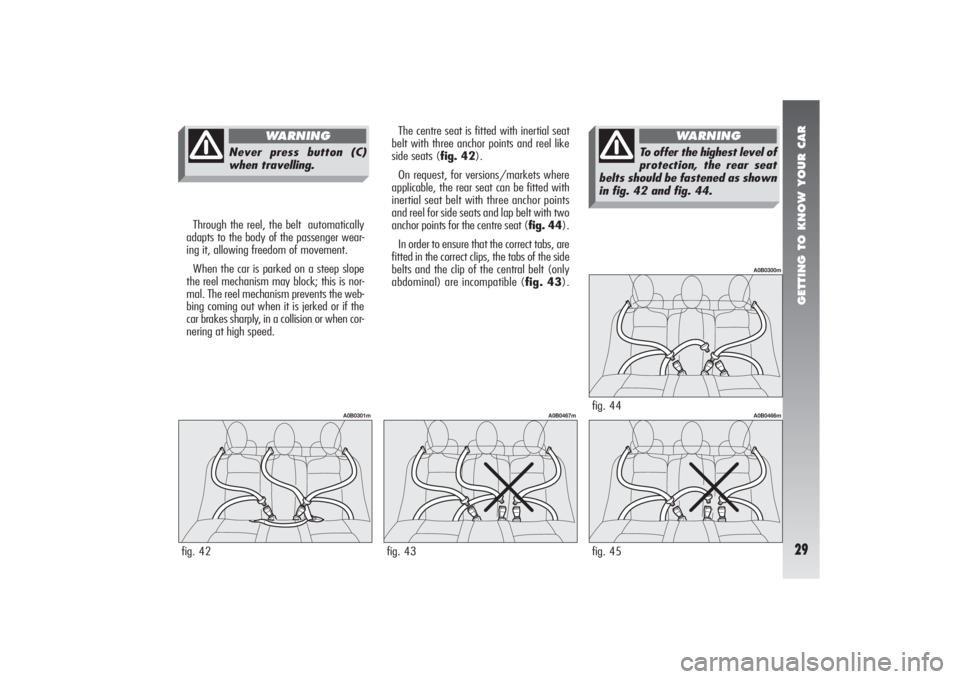
GETTING TO KNOW YOUR CAR29
fig. 44
A0B0300m
Through the reel, the belt automatically
adapts to the body of the passenger wear-
ing it, allowing freedom of movement.
When the car is parked on a steep slope
the reel mechanism may block; this is nor-
mal. The reel mechanism prevents the web-
bing coming out when it is jerked or if the
car brakes sharply, in a collision or when cor-
nering at high speed.
Never press button (C)
when travelling.
WARNING
The centre seat is fitted with inertial seat
belt with three anchor points and reel like
side seats (fig. 42).
On request, for versions/markets where
applicable, the rear seat can be fitted with
inertial seat belt with three anchor points
and reel for side seats and lap belt with two
anchor points for the centre seat (fig. 44).
In order to ensure that the correct tabs, are
fitted in the correct clips, the tabs of the side
belts and the clip of the central belt (only
abdominal) are incompatible (fig. 43).
fig. 45
A0B0466m
fig. 42
A0B0301m
fig. 43
A0B0467m
To offer the highest level of
protection, the rear seat
belts should be fastened as shown
in fig. 42 and fig. 44.
WARNING
Page 179 of 357
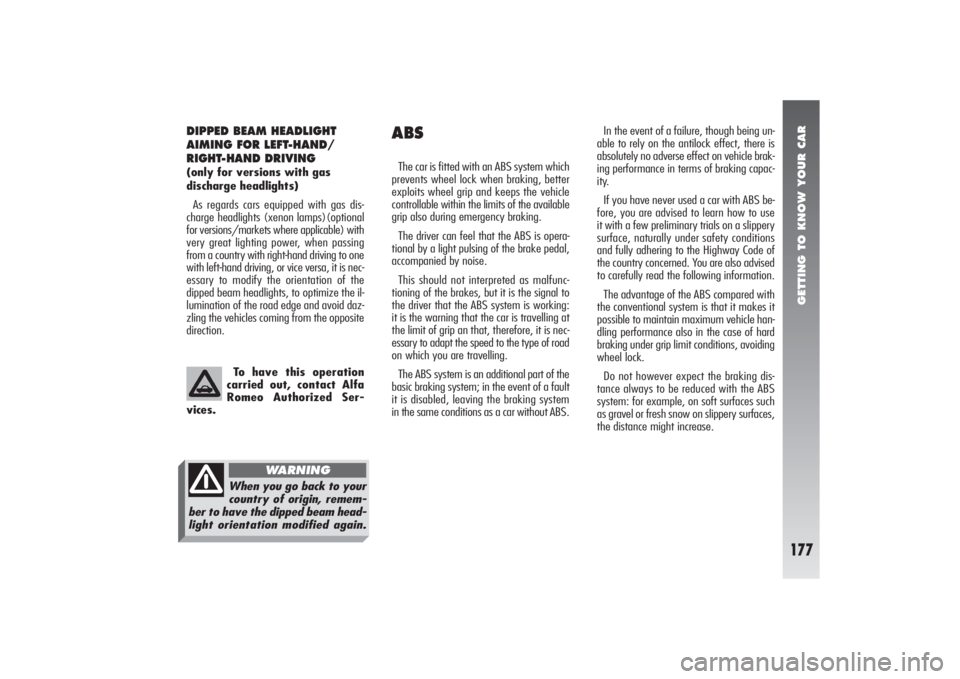
GETTING TO KNOW YOUR CAR
177
DIPPED BEAM HEADLIGHT
AIMING FOR LEFT-HAND/
RIGHT-HAND DRIVING(only for versions with gas
discharge headlights)
As regards cars equipped with gas dis-
charge headlights (xenon lamps)(optional
for versions/markets where applicable) with
very great lighting power, when passing
from a country with right-hand driving to one
with left-hand driving, or vice versa, it is nec-
essary to modify the orientation of the
dipped beam headlights, to optimize the il-
lumination of the road edge and avoid daz-
zling the vehicles coming from the opposite
direction.
To have this operation
carried out, contact Alfa
Romeo Authorized Ser-
vices.
When you go back to your
country of origin, remem-
ber to have the dipped beam head-
light orientation modified again.
WARNING
In the event of a failure, though being un-
able to rely on the antilock effect, there is
absolutely no adverse effect on vehicle brak-
ing performance in terms of braking capac-
ity.
If you have never used a car with ABS be-
fore, you are advised to learn how to use
it with a few preliminary trials on a slippery
surface, naturally under safety conditions
and fully adhering to the Highway Code of
the country concerned. You are also advised
to carefully read the following information.
The advantage of the ABS compared with
the conventional system is that it makes it
possible to maintain maximum vehicle han-
dling performance also in the case of hard
braking under grip limit conditions, avoiding
wheel lock.
Do not however expect the braking dis-
tance always to be reduced with the ABS
system: for example, on soft surfaces such
as gravel or fresh snow on slippery surfaces,
the distance might increase.
ABSThe car is fitted with an ABS system which
prevents wheel lock when braking, better
exploits wheel grip and keeps the vehicle
controllable within the limits of the available
grip also during emergency braking.
The driver can feel that the ABS is opera-
tional by a light pulsing of the brake pedal,
accompanied by noise.
This should not interpreted as malfunc-
tioning of the brakes, but it is the signal to
the driver that the ABS system is working:
it is the warning that the car is travelling at
the limit of grip an that, therefore, it is nec-
essary to adapt the speed to the type of road
on which you are travelling.
The ABS system is an additional part of the
basic braking system; in the event of a fault
it is disabled, leaving the braking system
in the same conditions as a car without ABS.
Page 181 of 357
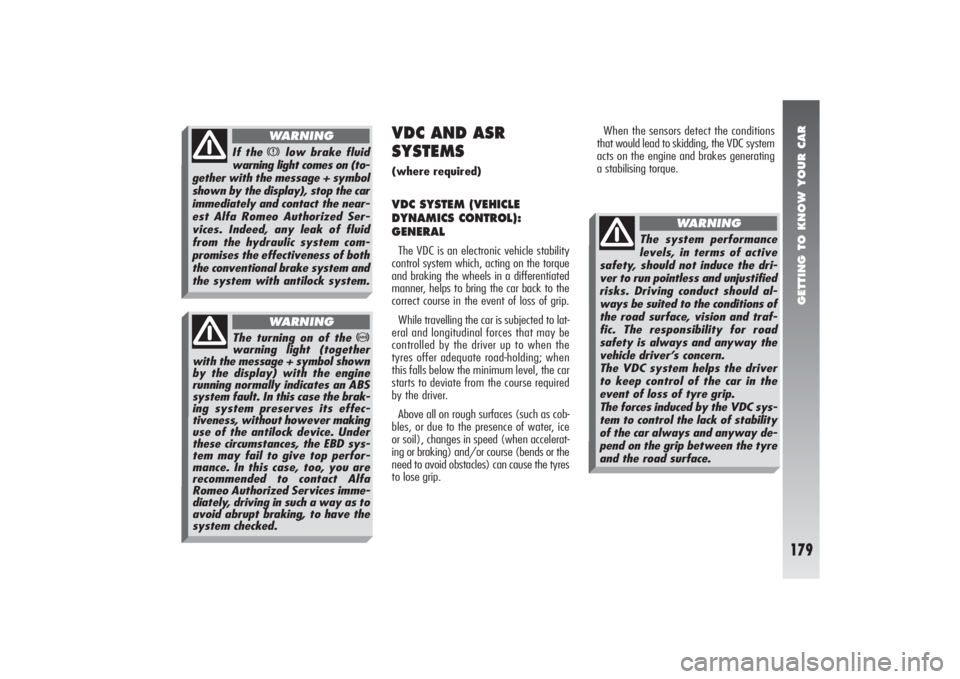
GETTING TO KNOW YOUR CAR
179
If the
x
low brake fluid
warning light comes on (to-
gether with the message + symbol
shown by the display), stop the car
immediately and contact the near-
est Alfa Romeo Authorized Ser-
vices. Indeed, any leak of fluid
from the hydraulic system com-
promises the effectiveness of both
the conventional brake system and
the system with antilock system.
WARNING
The turning on of the
>
warning light (together
with the message + symbol shown
by the display) with the engine
running normally indicates an ABS
system fault. In this case the brak-
ing system preserves its effec-
tiveness, without however making
use of the antilock device. Under
these circumstances, the EBD sys-
tem may fail to give top perfor-
mance. In this case, too, you are
recommended to contact Alfa
Romeo Authorized Services imme-
diately, driving in such a way as to
avoid abrupt braking, to have the
system checked.
WARNING
VDC AND ASR
SYSTEMS(where required)VDC SYSTEM (VEHICLE
DYNAMICS CONTROL):
GENERALThe VDC is an electronic vehicle stability
control system which, acting on the torque
and braking the wheels in a differentiated
manner, helps to bring the car back to the
correct course in the event of loss of grip.
While travelling the car is subjected to lat-
eral and longitudinal forces that may be
controlled by the driver up to when the
tyres offer adequate road-holding; when
this falls below the minimum level, the car
starts to deviate from the course required
by the driver.
Above all on rough surfaces (such as cob-
bles, or due to the presence of water, ice
or soil), changes in speed (when accelerat-
ing or braking) and/or course (bends or the
need to avoid obstacles) can cause the tyres
to lose grip.When the sensors detect the conditions
that would lead to skidding, the VDC system
acts on the engine and brakes generating
a stabilising torque.
The system performance
levels, in terms of active
safety, should not induce the dri-
ver to run pointless and unjustified
risks. Driving conduct should al-
ways be suited to the conditions of
the road surface, vision and traf-
fic. The responsibility for road
safety is always and anyway the
vehicle driver’s concern.
The VDC system helps the driver
to keep control of the car in the
event of loss of tyre grip.
The forces induced by the VDC sys-
tem to control the lack of stability
of the car always and anyway de-
pend on the grip between the tyre
and the road surface.
WARNING
Page 195 of 357
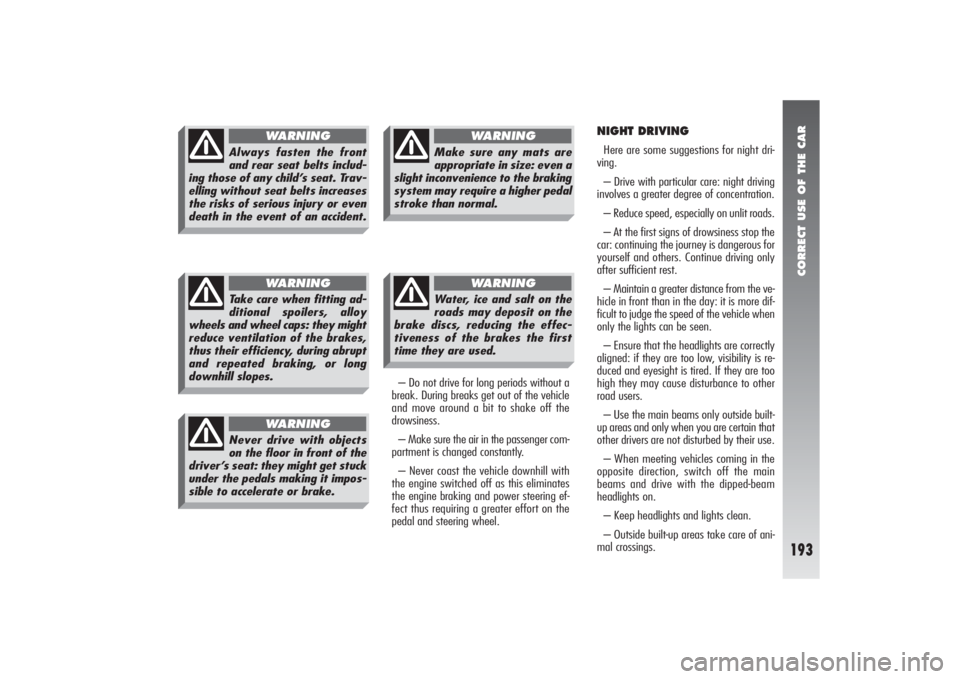
CORRECT USE OF THE CAR
193
– Do not drive for long periods without a
break. During breaks get out of the vehicle
and move around a bit to shake off the
drowsiness.
– Make sure the air in the passenger com-
partment is changed constantly.
– Never coast the vehicle downhill with
the engine switched off as this eliminates
the engine braking and power steering ef-
fect thus requiring a greater effort on the
pedal and steering wheel.
NIGHT DRIVINGHere are some suggestions for night dri-
ving.
– Drive with particular care: night driving
involves a greater degree of concentration.
– Reduce speed, especially on unlit roads.
– At the first signs of drowsiness stop the
car: continuing the journey is dangerous for
yourself and others. Continue driving only
after sufficient rest.
– Maintain a greater distance from the ve-
hicle in front than in the day: it is more dif-
ficult to judge the speed of the vehicle when
only the lights can be seen.
– Ensure that the headlights are correctly
aligned: if they are too low, visibility is re-
duced and eyesight is tired. If they are too
high they may cause disturbance to other
road users.
– Use the main beams only outside built-
up areas and only when you are certain that
other drivers are not disturbed by their use.
– When meeting vehicles coming in the
opposite direction, switch off the main
beams and drive with the dipped-beam
headlights on.
– Keep headlights and lights clean.
– Outside built-up areas take care of ani-
mal crossings.
Always fasten the front
and rear seat belts includ-
ing those of any child’s seat. Trav-
elling without seat belts increases
the risks of serious injury or even
death in the event of an accident.
WARNING
Take care when fitting ad-
ditional spoilers, alloy
wheels and wheel caps: they might
reduce ventilation of the brakes,
thus their efficiency, during abrupt
and repeated braking, or long
downhill slopes.
WARNING
Never drive with objects
on the floor in front of the
driver’s seat: they might get stuck
under the pedals making it impos-
sible to accelerate or brake.
WARNING
Make sure any mats are
appropriate in size: even a
slight inconvenience to the braking
system may require a higher pedal
stroke than normal.
WARNING
Water, ice and salt on the
roads may deposit on the
brake discs, reducing the effec-
tiveness of the brakes the first
time they are used.
WARNING
Page 196 of 357
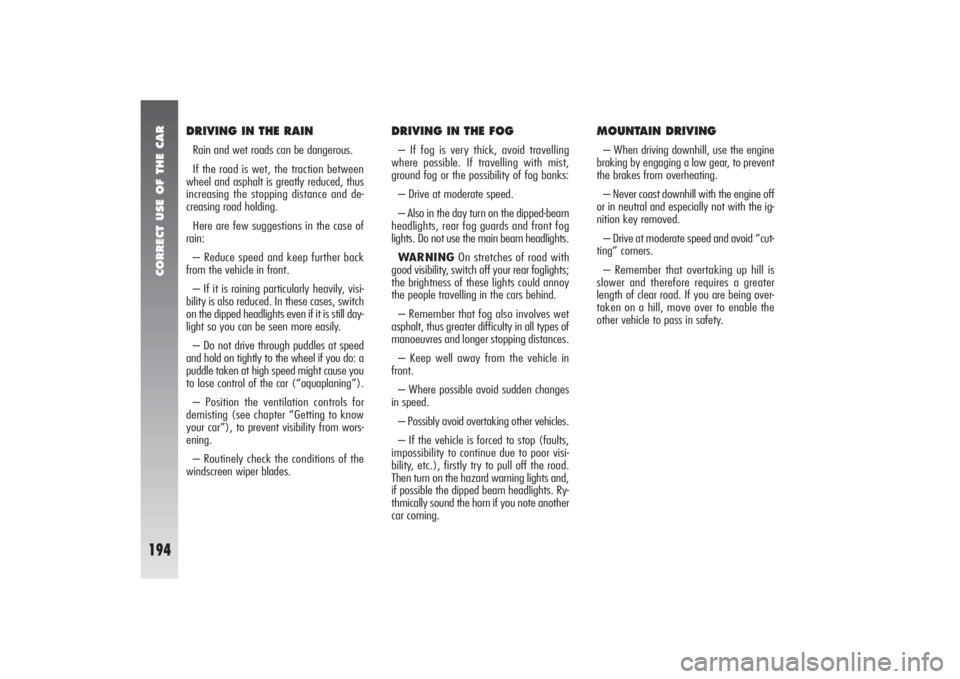
CORRECT USE OF THE CAR
194
DRIVING IN THE RAINRain and wet roads can be dangerous.
If the road is wet, the traction between
wheel and asphalt is greatly reduced, thus
increasing the stopping distance and de-
creasing road holding.
Here are few suggestions in the case of
rain:
– Reduce speed and keep further back
from the vehicle in front.
– If it is raining particularly heavily, visi-
bility is also reduced. In these cases, switch
on the dipped headlights even if it is still day-
light so you can be seen more easily.
– Do not drive through puddles at speed
and hold on tightly to the wheel if you do: a
puddle taken at high speed might cause you
to lose control of the car (“aquaplaning”).
– Position the ventilation controls for
demisting (see chapter “Getting to know
your car”), to prevent visibility from wors-
ening.
– Routinely check the conditions of the
windscreen wiper blades.
DRIVING IN THE FOG– If fog is very thick, avoid travelling
where possible. If travelling with mist,
ground fog or the possibility of fog banks:
– Drive at moderate speed.
– Also in the day turn on the dipped-beam
headlights, rear fog guards and front fog
lights. Do not use the main beam headlights.
WARNINGOn stretches of road with
good visibility, switch off your rear foglights;
the brightness of these lights could annoy
the people travelling in the cars behind.
– Remember that fog also involves wet
asphalt, thus greater difficulty in all types of
manoeuvres and longer stopping distances.
– Keep well away from the vehicle in
front.
– Where possible avoid sudden changes
in speed.
– Possibly avoid overtaking other vehicles.
– If the vehicle is forced to stop (faults,
impossibility to continue due to poor visi-
bility, etc.), firstly try to pull off the road.
Then turn on the hazard warning lights and,
if possible the dipped beam headlights. Ry-
thmically sound the horn if you note another
car coming.
MOUNTAIN DRIVING– When driving downhill, use the engine
braking by engaging a low gear, to prevent
the brakes from overheating.
– Never coast downhill with the engine off
or in neutral and especially not with the ig-
nition key removed.
– Drive at moderate speed and avoid “cut-
ting” corners.
– Remember that overtaking up hill is
slower and therefore requires a greater
length of clear road. If you are being over-
taken on a hill, move over to enable the
other vehicle to pass in safety.
Page 251 of 357
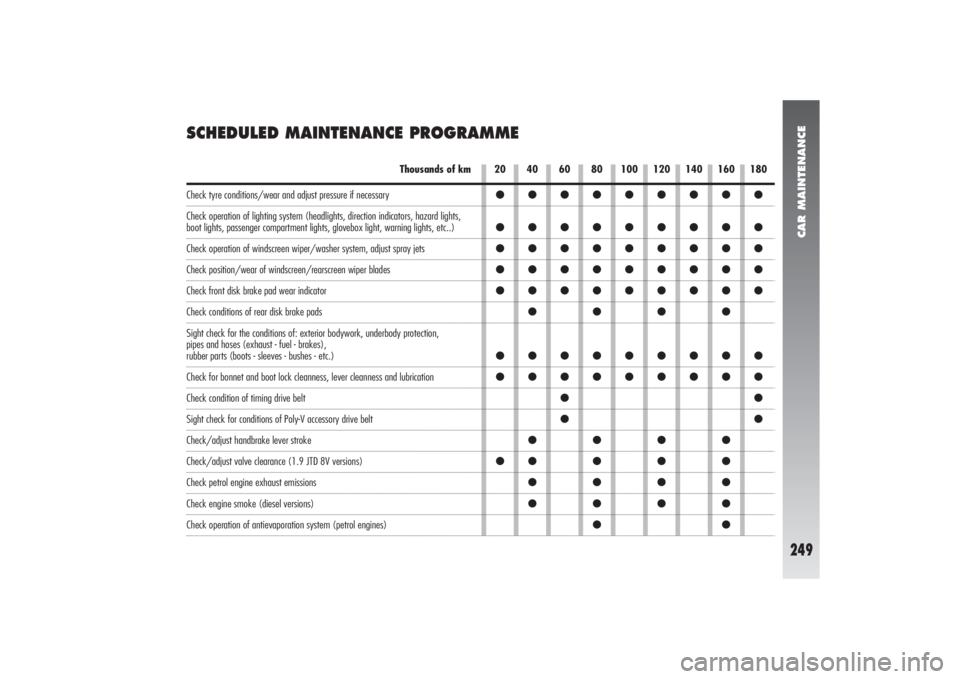
CAR MAINTENANCE
249
SCHEDULED MAINTENANCE PROGRAMME
20 40 60 80 100 120 140 160 180
Thousands of km
●●●●●●●●●
●●●●●●●●●
●●●●●●●●●
●●●●●●●●●
●●●●●●●●●
●●●●
●●●●●●●●●
●●●●●●●●●
●●
●●
●●●●
●●●●●
●●●●
●●●●
●●
Check tyre conditions/wear and adjust pressure if necessary
Check operation of lighting system (headlights, direction indicators, hazard lights,boot lights, passenger compartment lights, glovebox light, warning lights, etc..)Check operation of windscreen wiper/washer system, adjust spray jetsCheck position/wear of windscreen/rearscreen wiper bladesCheck front disk brake pad wear indicatorCheck conditions of rear disk brake pads
Sight check for the conditions of: exterior bodywork, underbody protection,
pipes and hoses (exhaust - fuel - brakes), rubber parts (boots - sleeves - bushes - etc.)Check for bonnet and boot lock cleanness, lever cleanness and lubricationCheck condition of timing drive beltSight check for conditions of Poly-V accessory drive beltCheck/adjust handbrake lever strokeCheck/adjust valve clearance (1.9 JTD 8V versions)Check petrol engine exhaust emissionsCheck engine smoke (diesel versions)Check operation of antievaporation system (petrol engines)
Page 252 of 357
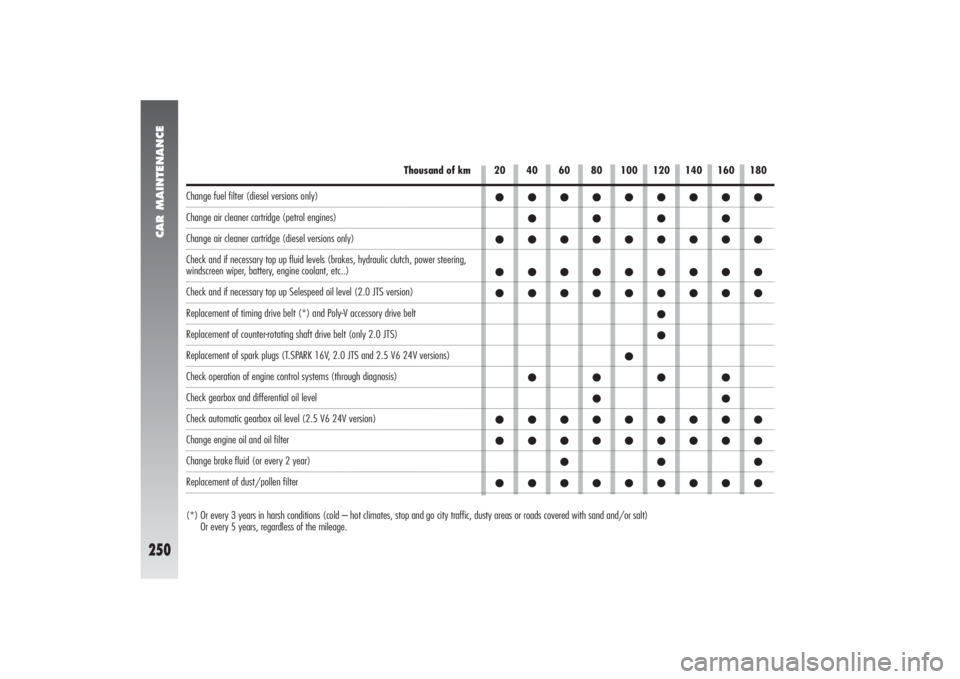
CAR MAINTENANCE
250
20 40 60 80 100 120 140 160 180
Thousand of km
Change fuel filter (diesel versions only)Change air cleaner cartridge (petrol engines)Change air cleaner cartridge (diesel versions only)
Check and if necessary top up fluid levels (brakes, hydraulic clutch, power steering, windscreen wiper, battery, engine coolant, etc..) Check and if necessary top up Selespeed oil level (2.0 JTS version)Replacement of timing drive belt (*) and Poly-V accessory drive beltReplacement of counter-rotating shaft drive belt (only 2.0 JTS)Replacement of spark plugs (T.SPARK 16V, 2.0 JTS and 2.5 V6 24V versions) Check operation of engine control systems (through diagnosis)Check gearbox and differential oil levelCheck automatic gearbox oil level (2.5 V6 24V version)Change engine oil and oil filterChange brake fluid (or every 2 year)Replacement of dust/pollen filter
●●●●●●●●●
●●●●
●●●●●●●●●
●●●●●●●●●
●●●●●●●●●
●
●
●
●●●●
●●
●●●●●●●●●
●●●●●●●●●
●●●
●●●●●●●●●
(*) Or every 3 years in harsh conditions (cold – hot climates, stop and go city traffic, dusty areas or roads covered with sand and/or salt)
Or every 5 years, regardless of the mileage.
Page 253 of 357
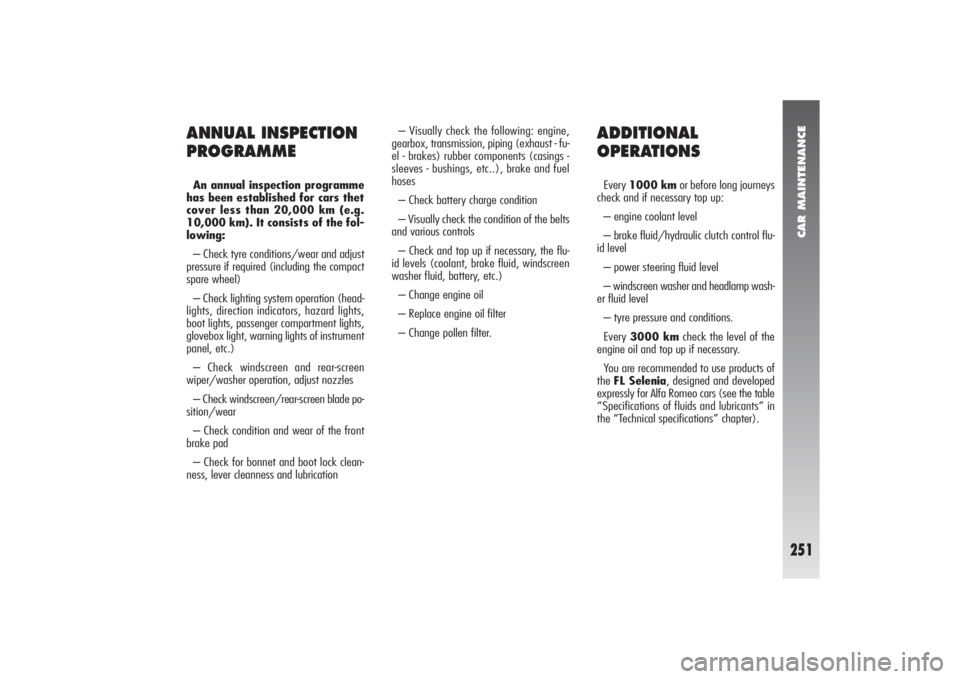
CAR MAINTENANCE
251
ADDITIONAL
OPERATIONSEvery 1000 kmor before long journeys
check and if necessary top up:
– engine coolant level
– brake fluid/hydraulic clutch control flu-
id level
– power steering fluid level
– windscreen washer and headlamp wash-
er fluid level
– tyre pressure and conditions.
Every 3000 kmcheck the level of the
engine oil and top up if necessary.
You are recommended to use products of
the FL Selenia, designed and developed
expressly for Alfa Romeo cars (see the table
“Specifications of fluids and lubricants” in
the “Technical specifications” chapter).
ANNUAL INSPECTION
PROGRAMMEAn annual inspection programme
has been established for cars thet
cover less than 20,000 km (e.g.
10,000 km). It consists of the fol-
lowing:
– Check tyre conditions/wear and adjust
pressure if required (including the compact
spare wheel)
– Check lighting system operation (head-
lights, direction indicators, hazard lights,
boot lights, passenger compartment lights,
glovebox light, warning lights of instrument
panel, etc.)
– Check windscreen and rear-screen
wiper/washer operation, adjust nozzles
– Check windscreen/rear-screen blade po-
sition/wear
– Check condition and wear of the front
brake pad
– Check for bonnet and boot lock clean-
ness, lever cleanness and lubrication– Visually check the following: engine,
gearbox, transmission, piping (exhaust - fu-
el - brakes) rubber components (casings -
sleeves - bushings, etc..), brake and fuel
hoses
– Check battery charge condition
– Visually check the condition of the belts
and various controls
– Check and top up if necessary, the flu-
id levels (coolant, brake fluid, windscreen
washer fluid, battery, etc.)
– Change engine oil
– Replace engine oil filter
– Change pollen filter.
Page 307 of 357
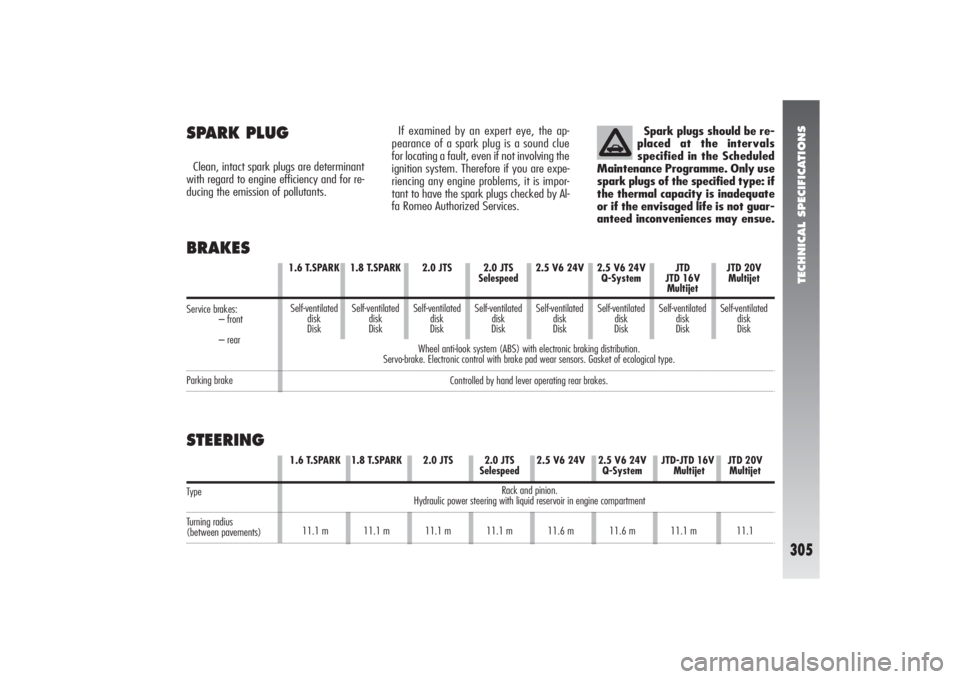
TECHNICAL SPECIFICATIONS
305
SPARK PLUGClean, intact spark plugs are determinant
with regard to engine efficiency and for re-
ducing the emission of pollutants.Spark plugs should be re-
placed at the intervals
specified in the Scheduled
Maintenance Programme. Only use
spark plugs of the specified type: if
the thermal capacity is inadequate
or if the envisaged life is not guar-
anteed inconveniences may ensue.BRAKESService brakes:
– front
– rearParking brake
If examined by an expert eye, the ap-
pearance of a spark plug is a sound clue
for locating a fault, even if not involving the
ignition system. Therefore if you are expe-
riencing any engine problems, it is impor-
tant to have the spark plugs checked by Al-
fa Romeo Authorized Services.
STEERING
1.6 T.SPARK 1.8 T.SPARK 2.0 JTS 2.0 JTS 2.5 V6 24V 2.5 V6 24V JTD JTD 20V
Selespeed Q-System JTD 16V Multijet
MultijetSelf-ventilated Self-ventilated Self-ventilated Self-ventilated Self-ventilated Self-ventilated Self-ventilated Self-ventilated
disk disk disk disk disk disk disk disk
Disk Disk Disk Disk Disk Disk Disk Disk
Wheel anti-look system (ABS) with electronic braking distribution.
Servo-brake. Electronic control with brake pad wear sensors. Gasket of ecological type.
Controlled by hand lever operating rear brakes.
Type Turning radius(between pavements)
1.6 T.SPARK 1.8 T.SPARK 2.0 JTS 2.0 JTS 2.5 V6 24V 2.5 V6 24V JTD-JTD 16V JTD 20V
Selespeed Q-System Multijet Multijet
Rack and pinion.
Hydraulic power steering with liquid reservoir in engine compartment
11.1 m 11.1 m 11.1 m 11.1 m 11.6 m 11.6 m 11.1 m 11.1
Page 328 of 357
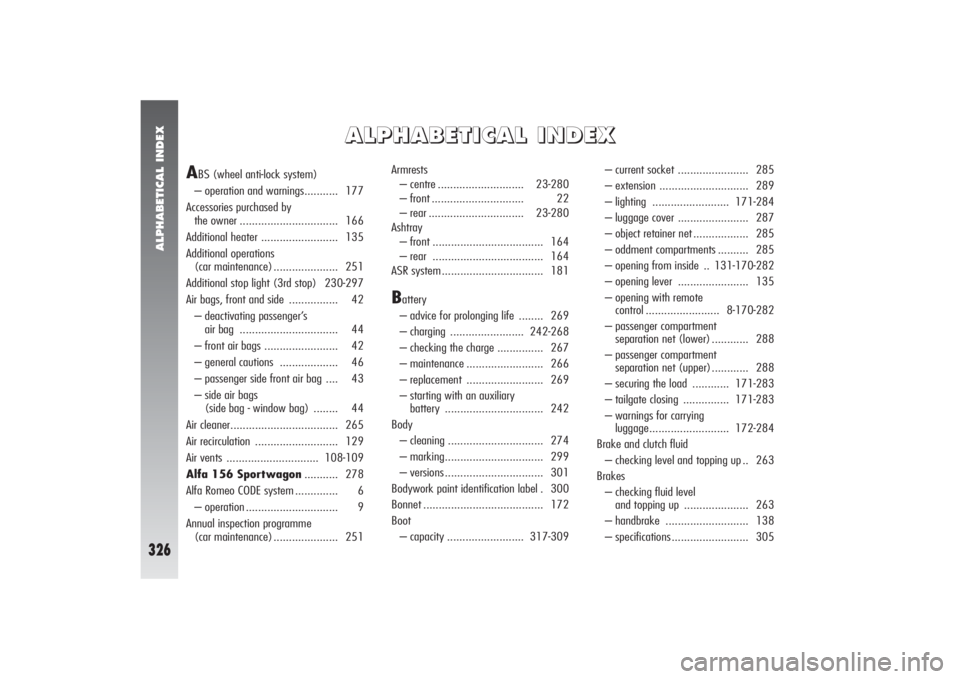
ALPHABETICAL INDEX
326
A A
L L
P P
H H
A A
B B
E E
T T
I I
C C
A A
L L
I I
N N
D D
E E
X X
A
BS (wheel anti-lock system)
– operation and warnings........... 177
Accessories purchased by
the owner ................................ 166
Additional heater ......................... 135
Additional operations
(car maintenance) ..................... 251
Additional stop light (3rd stop) 230-297
Air bags, front and side ................ 42
– deactivating passenger’s
air bag ................................ 44
– front air bags ........................ 42
– general cautions ................... 46
– passenger side front air bag .... 43
– side air bags
(side bag - window bag) ........ 44
Air cleaner................................... 265
Air recirculation ........................... 129
Air vents .............................. 108-109
Alfa 156 Sportwagon........... 278
Alfa Romeo CODE system .............. 6
– operation .............................. 9
Annual inspection programme
(car maintenance) ..................... 251Armrests
– centre ............................ 23-280
– front .............................. 22
– rear ............................... 23-280
Ashtray
– front .................................... 164
– rear .................................... 164
ASR system ................................. 181
Battery
– advice for prolonging life ........ 269
– charging ........................ 242-268
– checking the charge ............... 267
– maintenance ......................... 266
– replacement ......................... 269
– starting with an auxiliary
battery ................................ 242
Body
– cleaning ............................... 274
– marking................................ 299
– versions ................................ 301
Bodywork paint identification label . 300
Bonnet ....................................... 172
Boot
– capacity ......................... 317-309– current socket ....................... 285
– extension ............................. 289
– lighting ......................... 171-284
– luggage cover ....................... 287
– object retainer net .................. 285
– oddment compartments .......... 285
– opening from inside .. 131-170-282
– opening lever ....................... 135
– opening with remote
control ........................ 8-170-282
– passenger compartment
separation net (lower) ............ 288
– passenger compartment
separation net (upper)............ 288
– securing the load ............ 171-283
– tailgate closing ............... 171-283
– warnings for carrying
luggage.......................... 172-284
Brake and clutch fluid
– checking level and topping up .. 263
Brakes
– checking fluid level
and topping up ..................... 263
– handbrake ........................... 138
– specifications ......................... 305